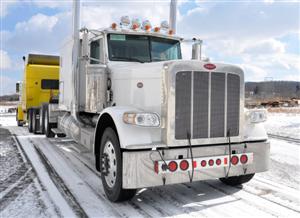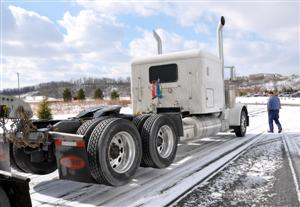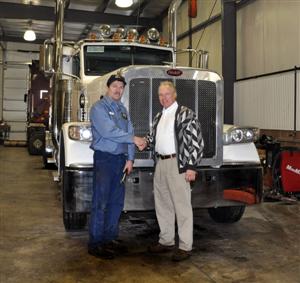March 2010 - Performance Zone
GOOD GEARING & MORE
By Performance Specialist Bruce C. Mallinson
As many of you know, we are in the process of building Peterbilt 389, Freightliner Coronado and Western Star glider kits. These are the only three glider kits available from the OEM’s, so if you want something else, please call the truck manufacturer and ask them. I called Kenworth about getting a T-660 glider but their answer was that it would take a lot of engineering to be able to install a 2002 or older engine into that chassis. I asked Kenworth to build me T-660 gliders without the engines and transmissions and told them that I’d do all the required engineering, but so far I have received no answer from Kenworth – all they want to sell me is a complete truck. The wait time to get a 2011 Peterbilt glider kit is over four months now, yet you can buy a 2011 truck with a DPF engine and get it in about six weeks. Peterbilt will only build two glider kits per week, so if you want one, you should call us and put a deposit down on one so we can get it ordered for you.
Last month we received our first Peterbilt glider kit, and this white flat top 389 will sit in our booth at the Mid-America trucking show. It will be powered by one of our completely remanufactured Signature 6NZ Caterpillar engines and have every item we have to produce power and fuel mileage. This 389 will have the Pittsburgh Powerbox installed, which will give it the ability to produce 800 horsepower, and we expect the fuel mileage to be 8 mpg or better. It will have an Eaton 18-speed double overdrive, just like the majority of owner-operator trucks on the road today, but it will have a 2:64 locker rear gear, which means you will drive this truck in direct gear. First overdrive will only be used for long downhill grades or if you just want to speed. So, why are we using the 18-speed Eaton? Because it has the ability to split a gear and it’s the highest torque rated transmission available for semi truck use – and with our Signature Series engines, we always exceed the torque ratings.
Many people feel that a truck with 2:64 rear gears will lose power on the hills and mountains, however the opposite is true. A truck equipped with 3:36 or 3:55 gears loses more power to the drive tires because of the overdrive transmission. Think about this: when pulling in direct gear, the engine only loses about 9% to 12% of its power through the drive train, however when pulling in double overdrive (18th gear with an 18-speed or 13th gear with a 13-speed) the power loss is between 30% and 40%. The same happens in a 10-speed overdrive transmission, so if you have a company truck with a 10 over and 3:55 or 3:73 rear gears, the same equation applies, the 10-speed just can’t split the gears.
Let’s get out a calculator and figure out what is going on here, in regards to horsepower, when using overdrive. Let’s use a 550 hp Cat engine putting about 490 hp to the rear wheels in direct gear. Keep in mind all hp figures to the rear wheels are in direct gear. Now, let’s use a multiplier of .70, figuring a 30% loss in double overdrive. The rear wheel horsepower for your 550 Cat is now only 390 hp. So, your 550 Cat (or whatever engine you have) only has 390 hp to the rear wheels in high gear, even if you have 550 at the crank. The same equation works if you have a 500 hp Detroit – it only puts 350 hp to the rear tires.
 Yes, our engines are more powerful today and because they run at lower RPM’s than the older mechanical engines, we are not putting much more hp to the rear wheels because of the double overdrive transmissions. When the engineers at Allison, makers of “The World Transmission” for motor homes and medium duty trucks, made their 6-speed Automatic, with 5th and 6th gear being overdrive, they lost 40% of their power to the rear wheels. A motor home with a 450 hp engine only has 290 hp to the rear wheels. The only good thing about the “The World Transmission” is that it has torque converter lockup in 2nd through 6th gear. So, the speed of the vehicle is determined in the rear gears, not the transmission. If you are a logger, pull an end dump or do heavy hauling and never see a four-lane highway, then the 2:64 gears are not for you. But, for most trucks, the 2:64 gearing is perfect for running on the interstate highway system.
Yes, our engines are more powerful today and because they run at lower RPM’s than the older mechanical engines, we are not putting much more hp to the rear wheels because of the double overdrive transmissions. When the engineers at Allison, makers of “The World Transmission” for motor homes and medium duty trucks, made their 6-speed Automatic, with 5th and 6th gear being overdrive, they lost 40% of their power to the rear wheels. A motor home with a 450 hp engine only has 290 hp to the rear wheels. The only good thing about the “The World Transmission” is that it has torque converter lockup in 2nd through 6th gear. So, the speed of the vehicle is determined in the rear gears, not the transmission. If you are a logger, pull an end dump or do heavy hauling and never see a four-lane highway, then the 2:64 gears are not for you. But, for most trucks, the 2:64 gearing is perfect for running on the interstate highway system.
Several of my friends and clients that I have met over the years of building engines are into extreme heavy hauling. With efforts from these guys, Sid Compton and I have put together a combination of components that will make the ultimate heavy haul truck. Who is Sid Compton, you ask? Sid Compton is the builder of the most powerful diesel engines this world has ever seen, and now he works with us at Pittsburgh Power. I’ll talk more about Sid later. Anyways, instead of using two trucks to haul the load – one semi truck to pull and one to push – we are going to build a single truck with enough power and cubic inches to pull 400,000+ pounds!
Last week I got a phone call from a client who has a Bridge Cat that we un-bridged – he was pulling 404,000 pounds across West Virginia. His Cat, which now produces 600 hp, was pulling from the front, while another truck, powered by another 600 hp Cat, was pushing from behind. The top speed they could achieve on the hills was 7 mph. Fuel mileage is of no concern when pulling 404,000 pounds, but power is. I said to him, “Let me build you a truck that will pull that load by itself and allow you to go up those hills at 21 mph.” Since then, we have put together the specs to build a truck that will pull an awesome amount of weight with authority – even up the hills. The rears of this heavy haul truck of the future will be capable of hauling 102,000 pounds on the deck. The transmission that we are having built will be able to harness 7,000 ft. lbs. of torque, and it’s only a 9-speed. With 2,300 cubic inches, 38 liters and 1,800 horsepower, we will only need 9-speeds!
 Sid Compton and I have known each other for the past 27 years and I have always been amazed at what this man could get out of a diesel engine – like 2,400 hp from a KTA 1,150 cu. in. Cummins. Many of you have seen this engine at work in a pulling Pete called Mr. Nasty owned by Doc Snyder of Snyder Farms in Ohio. Sid also built CFI’s famous Red Racer T-2000 KW that ran Pikes Peak with two back-to-back Signature 600 Cummins engines under the cab. Yes, that was an inline 12-cylinder engine. Remember the Wild Thing I and II? Those trucks were Internationals that were built to race Pikes Peak by Cummins and IHC. The N-14 Celect engines in Wild Thing I and II both produced 1,000 hp. Sid was the man that built those trucks and raced them up Pikes Peak – he even ran one of them off the road above the tree line and fell 600 feet. The hefty roll cage that he built saved his life.
Sid Compton and I have known each other for the past 27 years and I have always been amazed at what this man could get out of a diesel engine – like 2,400 hp from a KTA 1,150 cu. in. Cummins. Many of you have seen this engine at work in a pulling Pete called Mr. Nasty owned by Doc Snyder of Snyder Farms in Ohio. Sid also built CFI’s famous Red Racer T-2000 KW that ran Pikes Peak with two back-to-back Signature 600 Cummins engines under the cab. Yes, that was an inline 12-cylinder engine. Remember the Wild Thing I and II? Those trucks were Internationals that were built to race Pikes Peak by Cummins and IHC. The N-14 Celect engines in Wild Thing I and II both produced 1,000 hp. Sid was the man that built those trucks and raced them up Pikes Peak – he even ran one of them off the road above the tree line and fell 600 feet. The hefty roll cage that he built saved his life.
I will be writing more about Sid Compton in several of my upcoming articles. When you come to visit our shop, be sure to discuss your engine problems with Sid – he is our new shop foreman and chief wrench – he’s the guy you’ll want and need to talk to. We at Pittsburgh Power Inc. consider it a pleasure to have Sid Compton working with us. Sid has been with us since the 18th of January, 2010. George Muntean, a retired head engineer at Cummins Engine Company Fuel Systems, said at a recent dinner, “With you (Bruce) and Sid working together, nothing will be impossible for Pittsburgh Power!” Thank you, George, for those kind and encouraging words.
Be sure to see us at the Mid-America Trucking Show (MATS) in booth 61132 in the West Wing of the Kentucky Exposition Center in Louisville, KY on March 25-27. Come on over and check out our latest fuel-saving Peterbilt equipped with one of our completely remanufactured Signature Series 6NZ Caterpillar engines and all sorts of goodies that provide power and efficiency. We hope to see you there!
As always, if you have any performance-related diesel engine comments or questions, please call me at Pittsburgh Power Inc. in Saxonburg, PA at (724) 360-4080 or send me an e-mail me at bruce@pittsburghpower.com. Also, check out our redesigned website at www.pittsburghpower.com.
